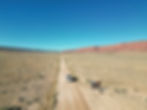Sandstone Sorcery: Exploring the Mind-Bending Landscapes of White Pocket
- Dan Wagner
- Sep 26
- 5 min read
Updated: Oct 6
Exploring White Pocket in Arizona is like walking on another planet. Tucked deep within Vermilion Cliffs National Monument, it's one of the most photogenic and surreal landscapes in the American Southwest. The remote sandstone formations swirl with vibrant layers of red, white, pink, and orange rock, creating breathtaking textures and colors that rival nearby The Wave. Every curve and ridge tells a story of ancient geology, shaped by wind and time into domes, folds, and wave-like patterns that seem to defy gravity. With no official trails or crowds, hiking White Pocket offers a true sense of adventure and solitude—perfect for photographers, hikers, and anyone seeking a one-of-a-kind desert experience. From sunrise to sunset, this remote wonder in northern Arizona delivers unforgettable views and endless opportunities for exploration.


Trailhead elevation 5,682'
Water extremely scarce
Don't miss sunrise and/or sunset
Exploring White Pocket
After a few days exploring Great Basin National Park, Dad and I pointed the truck south toward Kanab for some hiking and Milky Way photography. Originally, White Pocket was on the plan four days from now, but with the forecast showing tonight as the only clear evening, we decided to make the push. From Baker, Nevada it was a four-hour drive to Kanab, a quick resupply, and then onto House Rock Valley Road. By 4:30 p.m., we were entering Vermilion Cliffs National Monument.

The first 9.3 miles down House Rock Valley Road were a breeze—just light washboard that we cruised over at 55 mph.

From there, we turned right onto Pine Tree Road, where a sign warned that 4x4 or 4WD was required. In truth, it didn’t feel that way yet. The road was rougher, with heavier washboard and a bit of sand, but nothing difficult. We passed through a cattle gate along the way—closing it behind us—before continuing on. Up to this point, the road was still wide enough for oncoming traffic to pass without issue.

About 6.3 miles later, we stopped near a house on the left and spotted a sign pointing straight ahead toward White Pocket. Here, we stopped to air the tires down to 20 PSI and dropped the Silverado into low gear.

A few hundred feet beyond, another sign directed us left, even though the GPS insisted we continue straight. With Google Maps unreliable these days, we trusted the signs and made the turn. Immediately, the surface shifted from washboard to deep sand, with ruts running 12–14 inches, and very few places to overcome oncoming traffic. I kept steady at 20 mph, weaving around rocks and staying in the tire tracks, twice nearly getting caught in soft turns. This road is no place for anything but a high-clearance 4x4.

By 6:30 p.m.—two hours after leaving Kanab—we arrived at the trailhead parking. Somehow, we had overlooked the time zone change from Kanab, leaving us with a bit less time than expected, but we made it nonetheless.

The evening was perfect: upper 60s, calm, and not a cloud in sight. Packs loaded, we set out. The trail began with 0.15 miles of deep sand before giving way to slickrock, and suddenly White Pocket’s surreal formations were right in front of us. With about an hour of sunlight left, Dad went to scout Milky Way photo spots while I launched my drone. As the sun dropped behind a distant mesa, the sandstone lit up. Muted yellows brightened, pale reds darkened to crimson, and the pink-orange swirls began to glow. I circled over a core formation streaked with crimson, orange, and yellow, its edges broken into polygonal “brain rock.”

Then I dropped down a slope to two more formations that caught the last light, their yellows and reds blazing in the sunset.


Climbing back up, I aimed my lens downward at the contorted folds and twisted sandstone layers—wave-like, strange, and utterly mesmerizing.

I then turned my attention to the “brain rock” that blankets much of White Pocket. It’s everywhere you look, carved into intricate patterns and contours that rank among the most stunning formations in the area.

Like much of White Pocket itself, the origins of the polygonal “brain rock” remain a mystery. Geologists have proposed a variety of theories over the decades, but none have been definitively proven.

With twilight settling in, we hiked back to the truck to gear up for night shooting. Our first stop was “The Tree,” a lone Ponderosa pine rising from a brain-rock depression. Dad set up lights and dialed in exposure, and before long the stars spilled out across the sky. At one point, he even caught me silhouetted on a dome, headlamp beaming straight into the Milky Way.

We then set out to find Thor’s Hammer, which we finally located after an exhaustive search. In daylight it’s easy to spot, but at night, the twisting sandstone maze can be surprisingly disorienting.

After about an hour and a half of shooting the Milky Way, we headed back to the trailhead. Dad crawled into the back of the truck for the night, while I pitched my tent nearby. I drifted off to the strains of Pink Floyd’s Pulse, the Milky Way stretching overhead—an unforgettable way to close our out-of-this-world evening. Come morning, I was up early with just enough time to send the drone skyward again and capture a few more shots before the rising sun washed the colors away.

After nearly losing my drone a few times the night before, I kept things simple in the morning, staying near the center of the pocket and shooting straight down to capture details I’d missed earlier.

We could have spent days wandering and photographing this bizarre landscape, but with other plans ahead—and our food and water nearly gone—we kept it to a quick overnighter. Still, it was enough time to gain a real appreciation for the kind of wonders Mother Nature can dream up. Overall, we covered about 4.5 miles across two trips, though we easily could have doubled that distance if time had allowed.

White Pocket may cover only a small area, but exploring its terrain takes patience—there’s hardly a single flat step to be found. In my opinion, the northern (or rightmost) section as you approach is the most photogenic, home to the most striking swirls and sculpted formations.

Still, the southern area has its own unique appeal, featuring sights like Lone Tree and Thor’s Hammer. Sunrise and sunset are undoubtedly the best times to explore and photograph White Pocket, when the rocks glow with vibrant color. After dark, the skies here are some of the clearest and darkest you’ll ever see—perfect for stargazing or night photography.

By 8:00, we were on our way, carefully picking our way along the sandy road that keeps many from experiencing this extraordinary place. In an era of social media-fueled crowds, perhaps it’s fortunate that White Pocket remains so remote and challenging to reach. Whatever the case, all I can truly say is that it’s one of the most remarkable landscapes on Earth—one that inspires awe, commands respect, and deserves nothing less than full admiration. Thankfully, I got to experience it with my dad, a man who cherishes the thrills of nature and the wonders of the night sky like no one else I know.
_edited.png)

























































